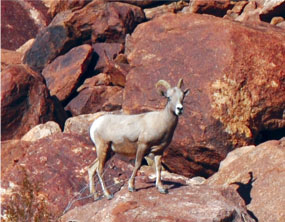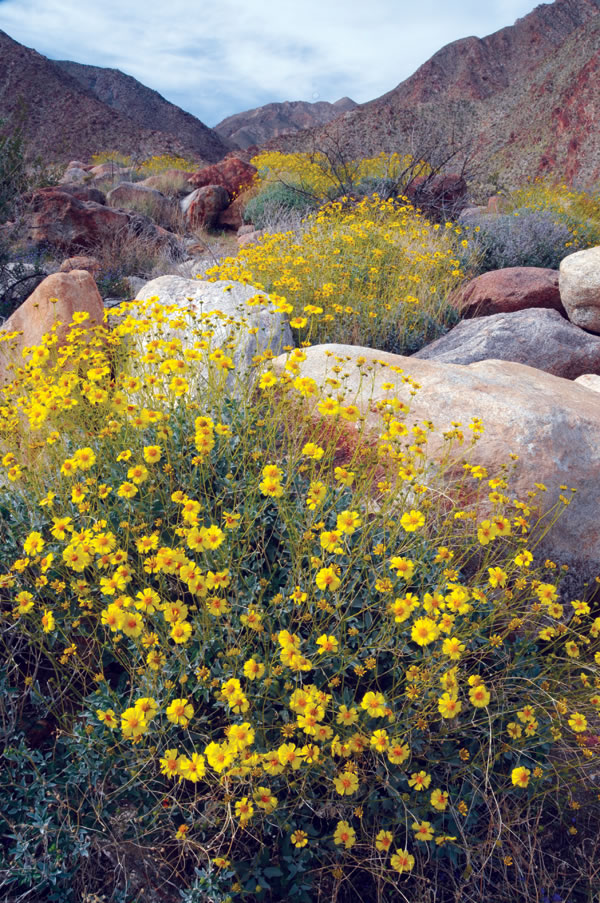San Diego County, in the far southwestern corner of the United States, mixes fog-bound coastal areas with scorching inland deserts and mountain ranges that often top 6,000 feet in elevation. With that geographical diversity, it is not surprising that San Diego has more biodiversity than any other county on the continent.
Spring flowers brighten Palm Canyon in 600,000-acre Anza-Borrego Desert State Park.
Roughly three million people also live here, jeopardizing the future of many species of plants, animals and fish. Specifically, over 200 species here are listed as rare, threatened or endangered, making San Diego County one the leading conservation “hotspots” in the nation. Using endangered species regulations as leverage, conservation organizations have helped San Diego County join with municipalities and governmental agencies at every level to craft one of the most ambitious habitat preservation strategies in the United States and, in the process, to assemble an impressive open space network.
 A multiple species conservation program, or MSCP, is designed to protect the habitat of multiple rather than individual species. Within San Diego County, three MSCPs are underway on different timetables. The East County MSCP was still under development as of 2008. The North County MSCP was approved in 2003 but, as of 2008, only one of its seven cities had adopted it. The North County Plan is designed to protect more than 80 sensitive species and conserve roughly 19,000 acres of habitat, of which almost half is already preserved. The South County MSCP was adopted in 1997 and is progressing toward its goal of protecting 98,379 acres. As of the end of 2007, the South County MSCP had preserved 65,214 acres, or roughly two thirds of its goal.
A multiple species conservation program, or MSCP, is designed to protect the habitat of multiple rather than individual species. Within San Diego County, three MSCPs are underway on different timetables. The East County MSCP was still under development as of 2008. The North County MSCP was approved in 2003 but, as of 2008, only one of its seven cities had adopted it. The North County Plan is designed to protect more than 80 sensitive species and conserve roughly 19,000 acres of habitat, of which almost half is already preserved. The South County MSCP was adopted in 1997 and is progressing toward its goal of protecting 98,379 acres. As of the end of 2007, the South County MSCP had preserved 65,214 acres, or roughly two thirds of its goal.
Federal and state agencies have committed to conserve and manage 36,510 acres in the South County MSCP preserve. The U.S. Bureau of Land Management controls the majority of this land, primarily in the Otay Mountain/Kuchamma Cooperative Management Area surrounding Otay Mountain just north of the U.S.-Mexico border. The National Wildlife Refuge System contributes the Sweetwater Marsh, Tijuana Slough and San Diego refuges to the MSCP. The State of California adds habitat to the MSCP preserve through the Silver Strand State Beach, Torrey Pines State Reserve, San Pasqual Battlefield State Historic Park, Borderfield State Park and five ecological reserves.
The federal and state governments have also contributed to open space preservation outside the MSCP preserve. For example, most of the 567,000-acre Cleveland National Forest lies within San Diego County. Likewise, California maintains a total of 16 state parks and beaches in San Diego County including the 600,000-acre Anza-Borrego Desert State Park.
Local governments contributed 45,240 acres of publically-owned habitat to the MSCP preserve. Roughly one-sixth of this total is managed by San Diego County in Sycamore Canyon County Open Space Preserve, Tijuana River Valley Open Space Preserve and Lakeside County Park. Cities committed another 24,090 acres, most notably the City of San Diego with the 5,900-acre Mission Trails Regional Park and the 4,000-acre Los Penasquitos Canyon Preserve.
San Diego County and its cities also preserve a substantial amount of land outside the South County MSCP preserve. In addition to approximately 6,000 acres of traditional parkland, San Diego County safeguards another 16,000 acres in 17 open space preserves offering roughly 100 miles of hiking and equestrian trails.
In addition to the open space committed to the MSCP preserve, the City of San Diego secures another 11,000 acres of open space in canyon preserves and traditional parks. Multi-jurisdictional partnerships have also formed for larger projects. For example, in the San Dieguito River Regional Park Joint Powers Authority (JPA), San Diego County joins forces with five incorporated cities to create a greenway extending from Del Mar on the Pacific Ocean 55 miles inland to Volcan Mountain.
Through the combined efforts of governments, multiple-species conservation programs and conservation organizations, San Diego is steadily protecting the habitat needed for the survival of its many threatened plants, animals and fish. And since that habitat often doubles as an outdoor playground, the resulting open space network provides refuge for beleaguered humans as well as other endangered species.

